Japanese Design Archive Survey
DESIGN ARCHIVE
Kenji Ekuan
Industrial Designer
Interview: 25 October 2016, 15:00 - 16:30
Location: GK Design Organization
Interviewee: Junko Onodera
Interviewer: Yasuko Seki, Akiko Wakui
Author: Akiko Wakui
PROFILE
profile
Kenji Ekuan
Industrial Designer
1929 Born in Tokyo, Japan 1955 Graduated from Tokyo University of the Arts, Department of Design
1957 Established GK Industrial Design Institute, Director
1970 Chairman of Japan Industrial Design Association
1975 President of International Council of Industrial Design Organizations (ICSID)
1989 Chairman of GK Design Institute
1995 Founder and Chairman of Japan Institute of Design
1996 Founder and Chairman of the Forum Douguology
1989 General Producer of World Design Exposition
1998 Chairman of Design for the World
2015 He passed away at the age of 85
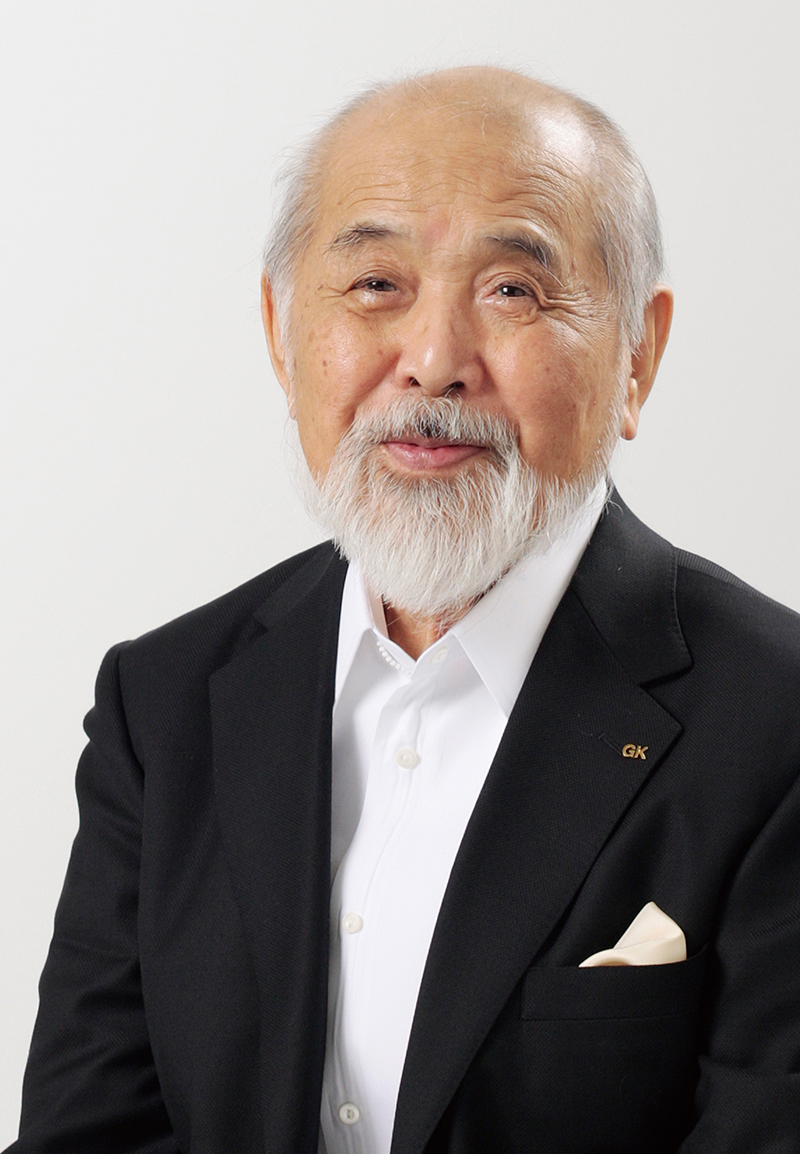
Description
Description
Kenji Ekuan, an industrial designer who left behind a great deal of achievements in the Japanese design world, passed away in February 2015. In postwar Japan, when the word "design" was not even recognised, Ekuan was one of the first to explain and spread the importance of design, and his influence was felt around the world. The masterpieces left behind by Ekuan include Kikkoman's soy sauce tabletop bottles, Yamaha motorcycles, and JR railroad cars, all of which support the modernization of Japanese life and urban space. He also worked hard to create an organisation that would open up the profession of design to society, and to conduct research that would delve deeply into the nature of people and design.
The starting point of Ekuan's design philosophy is the scene of the city of Hiroshima, which was turned into scorched earth by the atomic bomb. Houses disappeared, bicycles were burnt, trains were burnt, and the view of the Seto Inland Sea was nothing but a "horrible nothingness". He was born as the eldest son of the chief priest of a temple, and once he entered Buddhism to follow in his father's footsteps, his strong desire to bring "existence" back to this fierce world of "nothingness" drove him to devote his life to industrial design. From that time on, design became the same as living for Ekuan.
In 1952, while he was a student at Tokyo University of the Arts, he and his colleagues formed GK Industrial Design Office with the slogan "Democratization of Beauty" and "Democratization of Objects". 5 years later, they established GK Industrial Design Laboratory. Five years later, GK Industrial Design Laboratory was established. This created an unprecedented new trend in which a group of design specialists received orders for product design, which had previously been carried out within companies. Sixty years later, the GK Design Group has grown to include more than 200 freelance designers who work in all areas of design, not just industrial design.
Ekuan's activities were not limited to the category of a single designer, but he advocated and worked to popularise the concept of "Dougu (tool) theory," which views all artifacts in the world, from everyday items to urban spaces, as "tools," or things that are used in the way. The things that people need, that is, the things created by their will, are the alter ego of their hands and feet, and also the incarnation of their desires. In the 1960s, he participated in the "Metabolism Movement," an architectural design movement, with Masato Otaka, Fumihiko Maki, Kiyonori Kikutake, Kisho Kurokawa, Noboru Kawazoe, Kiyoshi Awazu, and others, and from the standpoint of industrial design, he promoted "Dougu theory research" that explored new forms of living space using "tools" as a starting point. Such research is still being carried out at the Forum Douguoligy and the Society for Douguoligy Studies.
In 2005, as a culmination of his research and enlightenment activities to build a proper relationship between human beings and tools, Ekuan launched the " Dougu Temple and the Dougu Village Concept" in order to realise "monozukuri" that leads to "human development. The idea was to reevaluate the significance of tools, saying, "There is no point in making tools unless people themselves grow by making them.
This passion for craftsmanship continued until the end of his 85-year life. He was not only a designer, but also a contributor to the development of the market from scratch in order to establish the profession and business of design in Japan, as well as an educator and activist who taught how people and design should be.
Masterpiece
Masterpiece
Product
Japan Musical Instruments Manufacturing (now Yamaha) Hi-Fi tuner "R3" (1954)
Kikkoman "Tabletop Soy Sauce Bottle" (1960)
Japan Musical Instruments Manufacturing (now Yamaha) Stereo Power Amplifier "B-6" (1980)
Japan Airlines executive class seat "JAL SHELL FLAT SEAT" (2002)
Railways and motorcycles
Yamaha Motor DT-1 (1968)
Osaka Expo Monorail (1970)
Yamaha Motor VMAX (1985)
Narita Express Series 253 NEX (1991)
Akita Shinkansen "Komachi" (1997)
Logotype
Logo mark of the Japan Central Racing Association (1987)
Tokyo Metropolitan Government symbol mark (1989)
Other
Dougu Theory Study: Nuclear Dwelling (Pumpkin House) (1964)
Tsukuba Expo Information Center (1985)
Concept of Dougu Temple and Dougu Village (2001)
Books
"Dogu Ko", Kajima Institute Publishing (1969)
" Makunouchi Bento no Bigaku (The Aesthetics of Makunouchi Lunchboxes)", Goma Shobo (1980)
" The Philosophy of Tools", PHP Institute (1980)
"The Discourses of Dougu", Kajima Institute Publishing (2000)
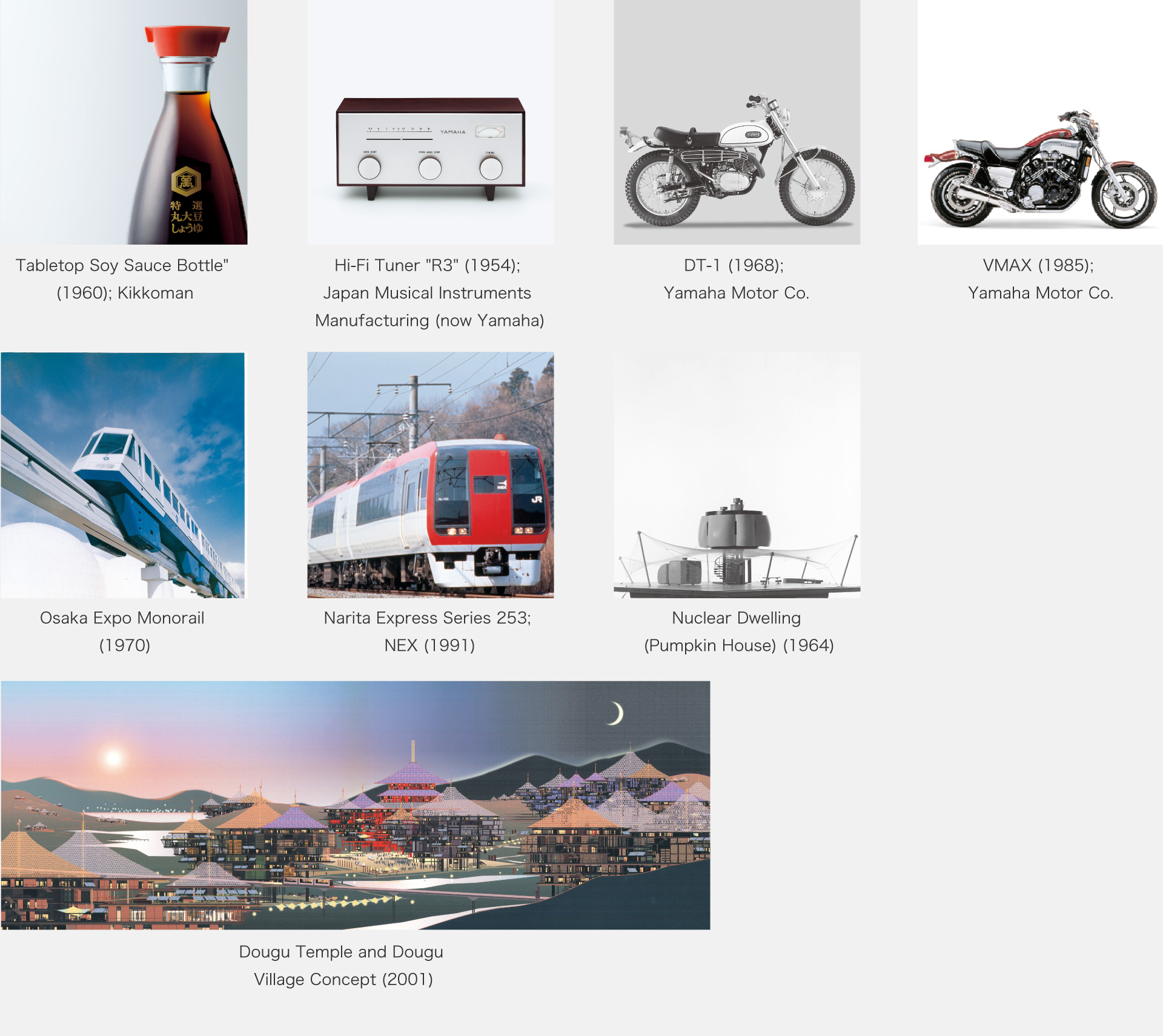
Interview
Interview
I think it is also important for people to understand that as a tool, it has a deep meaning for humans.
Huge archive existing in GK
ー It has been one year and eight months since Mr. Ekuan passed away. As a pioneer of industrial design, he left behind a great deal of achievements, and I think it is not an easy task to archive his achievements.
Onodera Of course, it was an unforeseen misfortune and we didn't know what to do with it. So for the first year I left it almost untouched, or perhaps I did so on purpose. So I can only tell you about the preliminary stages of the project, because we are still thinking about how to organise and store them.
ー It's been more than 60 years since Ekuan established GK Industrial Design Office, so the amount of work you have done during that time is enormous. Specifically, what kind of things are left?
Onodera When I look back on the footsteps of Ekuan after his death, I am deeply impressed by the accumulation and weight of the more than 60 years of history since the founding of GK. In 1952, GK Industrial Design Laboratory was established and I was appointed as the director. At the time of its establishment, GK won many prizes in design competitions, so we have the materials of those competitions, the detailed materials of the independent research of "Dougu Theory" which won the International Design Award from the Edgar J. Kauffman Foundation Fund in the U.S., and the drawings and the documents of his study at Art Center College of Design in the U.S. Art Center College of Design in the United States. In addition, I belonged to an international design organisation (ICSID), and since I became the president of ICSID, I have continued my overseas activities in design, and in particular, I have attended all the international conferences for many years and given many lectures. He also gave many lectures. In addition, since 1980, Ekuan held many exhibitions based on his ideas, and we have posters and records of these exhibitions, as well as calligraphy, sketches, and manuscripts drawn by Ekuan himself.
In particular, about 10 years before his death, he started to realise a grand plan to build a "Dougu Temple and Dougu Village" because he himself was a Buddhist. This project is to present the culmination of the many designs and craftsmanship I have been involved with over the years, and more and more exhibitions are being held with this meaning. The " Chichu Lenge " exhibition was also a part of this process. Unfortunately, his dream did not come true before his death, but I hope that one day GK members will succeed Ekuan's will and make it come true.
If you are interested in our design works, you can see GK's representative products in the gallery on the first floor.
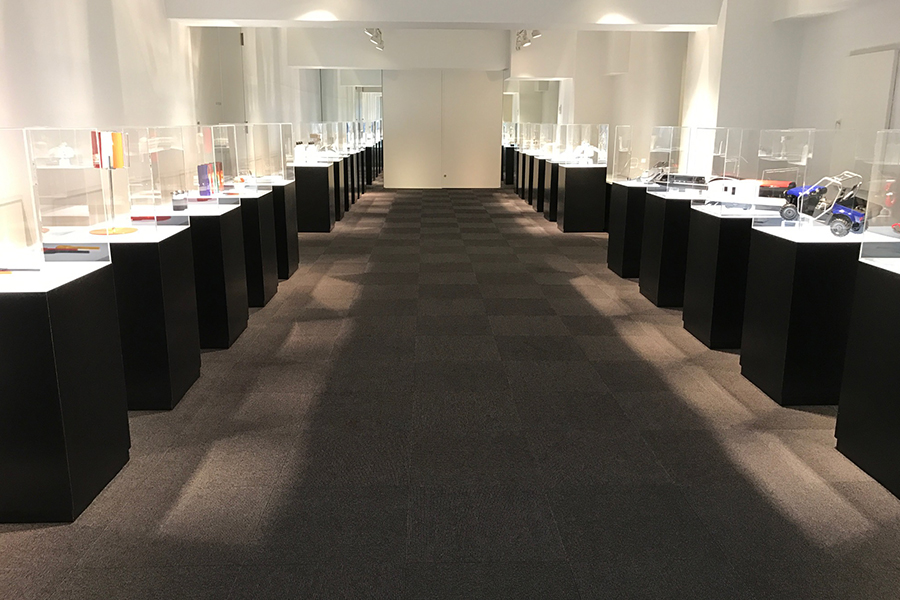

GK Gallery / Gallery on the 1st floor of GK Design Organization
ー You have a lot of publications and have been involved in a lot of exhibitions, so you must have a lot of material to work with. How do you plan to organise all of these valuable items?
Onodera We have just come to the time when we need to think about how to organise and store them. For your reference, GK has an "Articles Directory", which is a record of the activities of all GK members, centering on Ekuan, from the 1950s, when GK was founded, until 1987, when GK was spun off into a separate company. This is a record of all the magazines that appeared in the media at that time, introducing the products that we had designed up to that time and the background of their development. In the early days, we began by collecting photocopies and clippings of articles from design-related magazines such as "Kogei News" and "Design", which were still few and far between at that time, as well as from newspapers. As time went by, we accumulated "annual volumes", which became one of the most valuable materials to see the world and the background of the times. I believe that it may be useful for the history of Japanese design. Therefore, we have made a policy of storing Ekuan's magazines in data format and have started to work on them little by little.
In addition, the company has been publishing the journal "GK NEWS" since 1972, in which Ekuan, who was the chairman of the company, has been writing the preface of each issue and articles on various activities of the GK Group at that time, continuously by the members in charge. Each issue has its own "special theme," which beautifully depicts the way of perceiving the times and the new design proposals that emerge from it, etc. In 1989, the magazine was renewed as the present "GK Report," and it has continued for more than 45 years until today. We are trying to find a way to solve the problem by using various digital tools, while referring to those methods.
ー In this book, you can find articles that appeared in "Kogei News" and stories about Iwataro Koike and Noboru Kawazoe, which are now legendary. I think this is very valuable.
Onodera Thank you very much. At that time, it was the heyday of design, more and more designed products were coming out in the world, and it was also the time of high economic growth and many topics in the society. At that time, Ekuan introduced the word "Dougu" to design, and in 1968, he published "Dogu Theory" from Kajima Institute Publishing, which was the first book in which he expressed his "Dougu theory" that he had been advocating since the establishment of GK. In the book, he developed his original idea based on the recognition that "the world of people" and "the world of tools" share the same world, and this idea has been passed down to the next generation as the philosophy of GK, thanks to Ekuan's consistent persistence. The origin of Ekuan's aspiration to become a designer is based on the original scene of the atomic bombing of Hiroshima, which was called "the horrible nothingness". It might be a good idea to make a digital record of design ideas against the background of the times, or a modern version of the "General Catalogue of Articles".
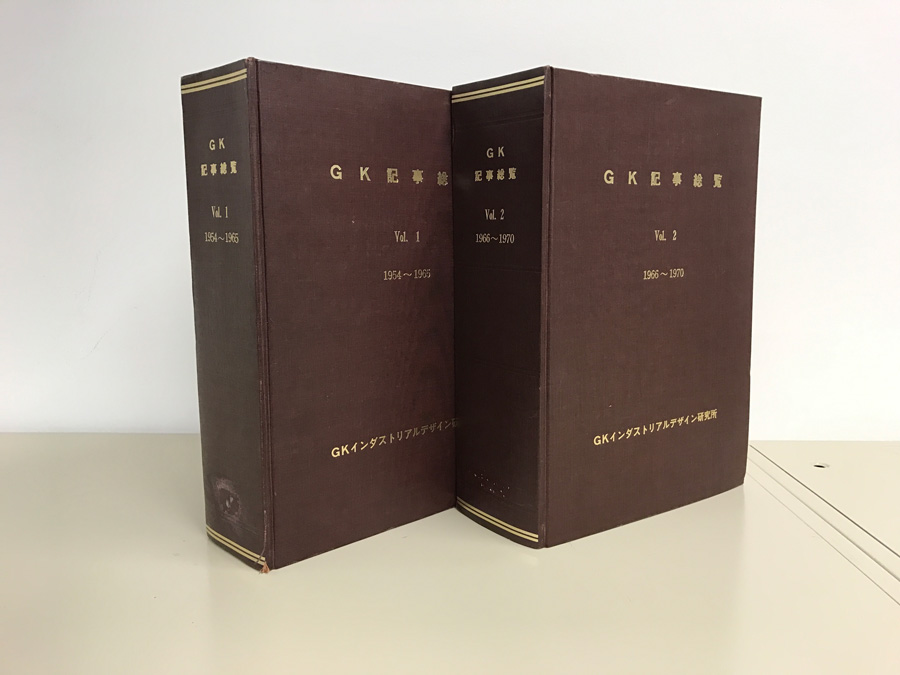
The "General Directory of Articles", which describes GK's activities from the 1950s to around 1987
ー Do you have any plans to sort through the things you left behind and use them for something in the future?
Onodera For us, organising is a way to look over everything again, and there is certainly a lot to learn in the process. I believe that it is our responsibility to continue to preserve these things for the next generation. At the moment, we are only thinking about organising and storing them, but we are finally starting to discuss how to make them into an archive within the GK, so that not only the GK but also the general public will be able to view them. That's why I feel like I have to do it again now that I've been asked to do this interview. Thank you very much for the good inspiration.
ー I am grateful to hear you say so. Anyway, with such a long history, wouldn't it be possible to build a museum just for GK?
Onodera It is true that GK has a strong presence in the Japanese design world, with a history of more than 60 years, and has been able to continue to this day. Since GK is basically based on team design, we have always had an "anonymous" mindset. That's why, even for the archives, we didn't have any particular intention to show them to the outside world. In particular, Ekuan has always been a leader of moving forward, moving forward, and we have mainly worked to create things with new ideas, so there have been many things that we have created, and it has been difficult to keep up with the speed of archiving them.
ー With the loss of your mainstay Ekuan-san, do you think now is the right time to reorganise as a goalkeeper?
Onodera That's right. This is the right time. Of course, each company in the Group, which is divided into different areas, will continue to operate in the same way as before, but we will certainly continue to maintain the GK design philosophy that Ekuan has left us, as well as the important ideas and corporate culture that only GK can cultivate as tradition. I think it is necessary to change to adapt to the change of the new era. To this end, we must create a new direction and vision for how we will move as a single group, GK. We are now in the process of examining this issue on a daily basis with the executives who will succeed us.
ー In that sense, the process of creating the archive will be a good opportunity for us to reaffirm Ekuan's design philosophy.
Onodera I think you are absolutely right. In the process of unraveling and rereading the documents one by one, we can understand many things again that we were not aware of at the time. I think it is important for us, who were working near Ekuan before his death, to understand what we thought we knew as if we were in the air, but now that he is no longer with us, we have to remember each of his words and understand them once again. I am also very grateful to him for leaving us a unique and precious asset. In the future, I believe that archiving is the most important thing in order to pass it on to the next generation.
The significance of preserving and conveying not only the form but also the background and ideas
ー There is a movement in Japan, led by Issey Miyake, to create a design museum. What do you think about this?
Onodera I have always thought it strange that there is no design museum in Japan, so I think it is really wonderful that Mr. Miyake is taking the lead in this project. Even if an individual has a collection, it takes a lot of space and manpower to store it, so it would be great if a proper public institution or facility could be established in Japan. In recent years, the number of design awards has been increasing, and I think it would be good to have a place where all the award-winning works of each organisation can be displayed together. I think this would provide a place where the Japanese public could gain a new understanding of design work. It would be a shame to see all the wonderful Japanese design products that have been produced go overseas. We also think that GK's works cannot be seen by anyone if they are left in the company, but if they are in a public museum, they may be seen permanently by people all over the world. I strongly feel that the way people from overseas look at Japanese craftsmanship will be different in a good way.
ー The question is how to exhibit them, isn't it? Masayuki Kurokawa told me during our series of interviews that product and industrial design is not something to be admired, but something that is closely related to our daily lives, so it is important to show the background and story behind it. Especially overseas, I think it is difficult to make an exhibition that takes into account the cultural and social background of Japan.
Onodera I think you're absolutely right that it's meaningless if you don't understand the background and narrative. Industrial design is mostly about products that we take for granted in our daily lives, so I think it is important for people to understand that as tools, they have a deep meaning for human beings. As stated in Ekuan's "Theory of Dougu", to put one's heart into something means to create its form, and after the modern era, design was the profession that was responsible for this creation. In this sense, the exhibition may also be viewed from the perspective of the relationship between humans and tools. By doing so, I think visitors will be able to understand the beauty of Japanese craftsmanship through technology and design, which is based on Japanese tradition and culture. In that sense, I think it's important to have a design museum in Japan.
ー Near this building, there was a room that was used by Ekuan, right? Are you planning to keep that room?
Onodera Yes, it is on the 9th floor of an apartment building in a quiet residential area of Mejiro, but it is also a place where historically valuable meetings have been held. It is also a place with a long history, as it is the place where all the deceased Kenzo Tange, Sakyo Komatsu, Taro Okamoto, Noboru Kawazoe, etc. gathered and held a conference. It is also a memorial place where many guests from overseas have visited. We have received some advice that we should establish a foundation. Ekuan himself was a man of great social influence and was highly regarded internationally, so I think it is worthwhile to establish a foundation.
ー To keep it semi-permanent, it might be a good idea to create a foundation.
Onodera Thank you very much. In that place, there are Ekuan's work room, a reception room for visitors, and a space for meetings. Ekuan's study, which is still maintained as it is, contains a Buddhist altar that he designed himself, a Buddhist statue, rods for his hobby of fishing elasmobranchs, hanging scrolls of mandalas, calligraphy brushes and inkstones, and tatami mats and lacquer furniture for napping under the desk. In the parlor, there are a lot of memorial items including rare works designed by Ekuan, gifts from customers and friends from all over the world, and things that he liked and bought in foreign countries. He was a person who kept everything he received, so he kept all the things he could not decorate in a box.
During the last five years of his life, each year on September 11, Ekuan's birthday, the GK Group companies would present him with a birthday present. Each company thought hard and prepared a creative gift that would please the Chairman, and each gift was unique to each company. We have displayed all of them, including those gifts. Also, some of the items on the glass shelves are not just placed on the shelves, but are intentionally arranged by Ekuan. If you look at them sometimes, you will find that the position of the figurines has been changed. Also, he always bought animal figurines in multiples, saying, "One figurine looks lonely, so put two together and they will take shape. This kind of consideration was also a part of Ekuan's kindness toward things.

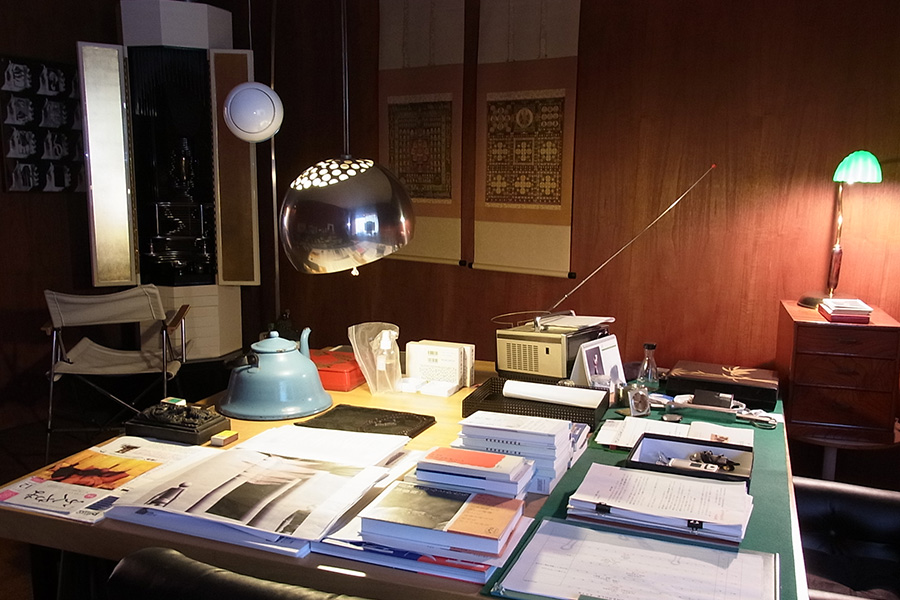
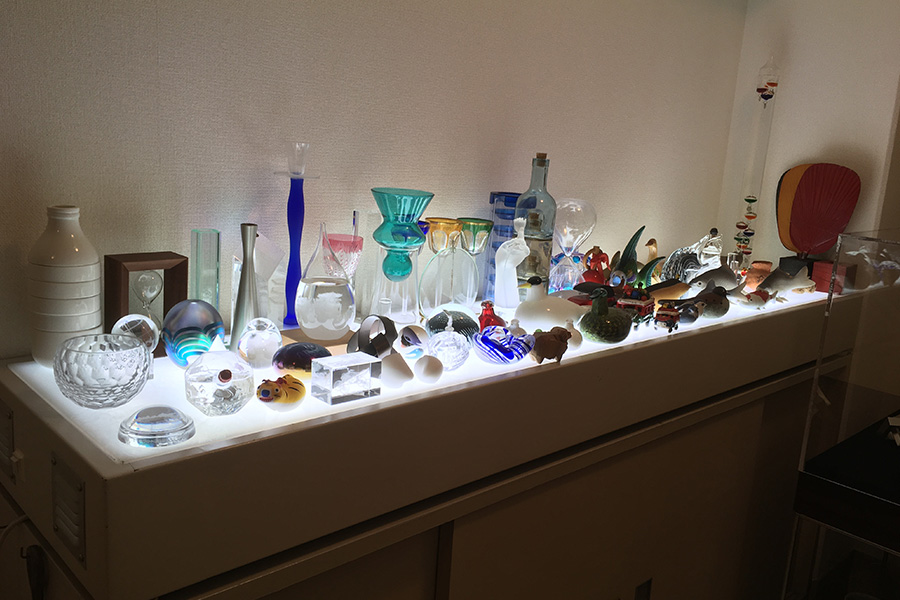
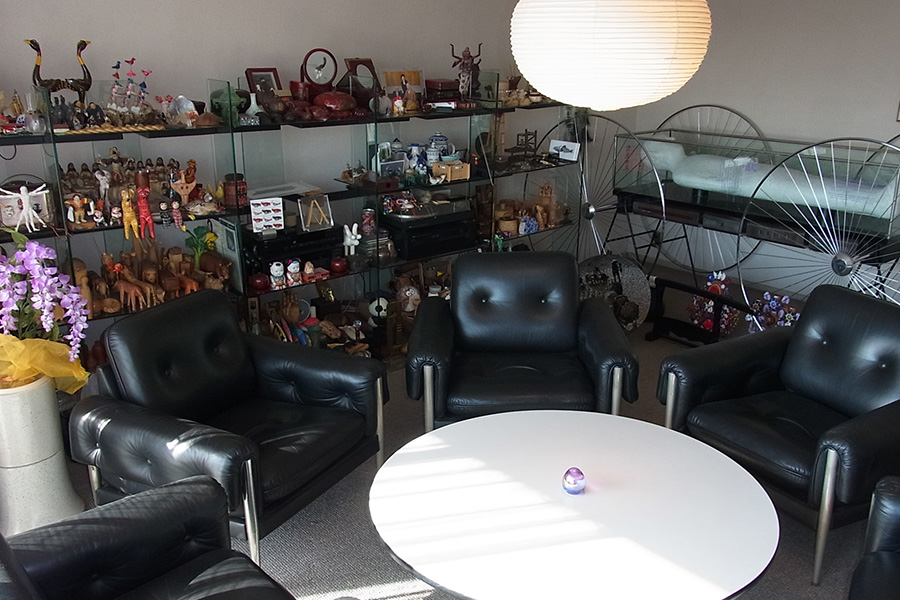
Room of Mr. Ekuan / Mr. Ekuan's studio in Mejiro
ー I had a chance to see the room, and it was a space filled with the philosophy of Mr. Ekuan, whose design was his life itself. I'm sure that designers would be more impressed if they saw it.
Onodera I believe that Ekuan's life was a design philosophy itself. Some of the things he collected in his later years were not for himself but rather for his employees to give them hints on how to make things. Each item has its own background and meaning that underlies the importance I continue to place on it. I think it was our belief that we should always be mindful of our relationship with people and things. That is why I think he spent the last years of his life working toward the realisation of his grand vision of the "Dougu Temple Dougu Village" as a culmination. In particular, for the week-long ascetic retreat in the mountains of Shirahama in Wakayama in 2006, we designed our own study room, chair, desk, lighting and bedroom. The only piece of clothing I wore was a samue designed by Mr. Miyake. It was a wonderful piece of work with all the tools woven into the back.
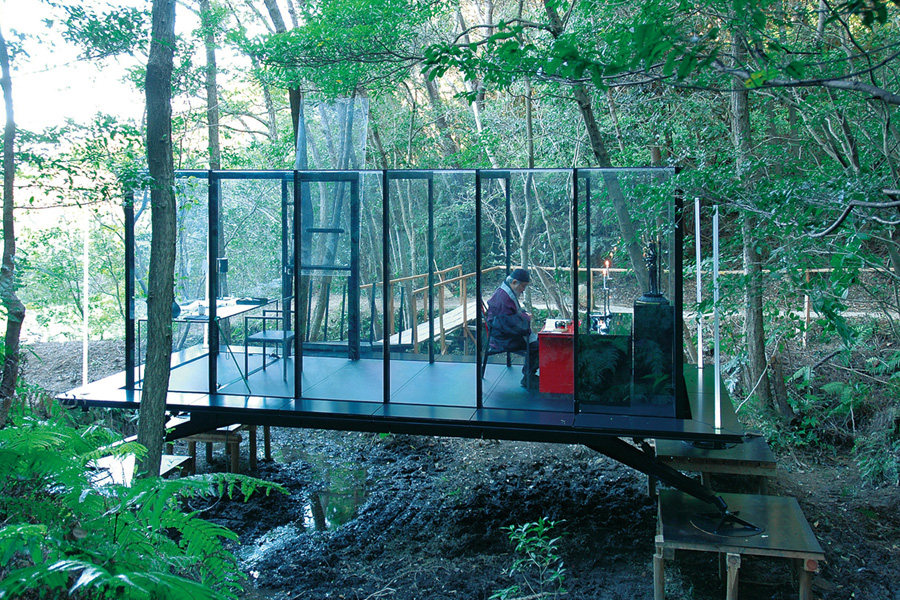
Mr. Ekuan training for his mountain retreat
ー We at PLAT are planning to hold workshops related to design archives from next year. For designers, the workplaces of other designers are very stimulating, so we would like to borrow such a place to discuss the significance and possibilities of the design archive. I would be very grateful if we could use the room in Mejiro where Ekuan's world view is embodied as the venue.
Onodera Of course, I would be very happy if you could use such an opportunity. I'm sure that the same creative people will be able to feel something just by coming here.
ー Thank you very much. I would like to talk to you again about the progress regarding the archives in the future, and I look forward to working with you on that. Thank you very much for your time today.
Location of Kenji Ekuan's archive
contact information (for inquiries) (e.g. corporate phone number)
GK Design Organization Inc. http://www.gk-design.co.jp

